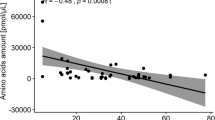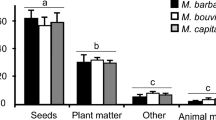Abstract
Diaspores of myrmecochorous plants consist of a seed (or fruit) and an attached appendage (elaiosome) which attracts ants. The elaiosome is a food resource for ants, whereas the seed is an energy source for subsequent germination and plant establishment. Although myrmecochory occurs in many phylogenetically unrelated lineages, multiple phylogenetic lineages display similar variation in elaiosome and seed metabolite composition due to convergent evolution. We focused on four families (Amaryllidaceae, Boraginaceae, Papaveraceae and Poaceae) each represented by two species from different genera. Diaspores of three populations per species were sampled and concentrations of 60 metabolites from five groups (amino acids, fatty acids, organic acids, polyols and sugars) were determined for both elaiosomes and seeds. Variability in metabolite composition was decomposed by hierarchical ANOVA and variation partitioning using redundancy analysis (reflecting both species nested within families, crossed with seed vs. elaiosome). Differences in the metabolite composition of elaiosomes and seeds were consistent across multiple phylogenetic origins (with more pronounced differences at the level of individual metabolites than at the level of metabolite groups) and supported the idea of convergent evolution under strong selection pressure. Elaiosomes contained higher amounts of easily digestible metabolites (especially amino acids) than seeds. Fatty acids were not more concentrated in elaiosomes, which contradicts the literal translation of “elaiosome” (= oil body). The differentiation of metabolite composition closely reflected taxonomic relatedness, particularly at the family level. Differences among populations within species were small, so the metabolite composition can thus be considered as a trait with relatively low intraspecific variability.






Similar content being viewed by others
References
Boieiro M, Espadaler X, Gomez C, Eustaquio A (2012) Spatial variation in the fatty acid composition of elaiosomes in an ant-dispersed plant: differences within and between individuals and populations. Flora 207:497–502. https://doi.org/10.1016/j.flora.2012.06.007
Boulay R, Coll-Toledano J, Cerda X (2006) Geographic variations in Helleborus foetidus elaiosome lipid composition: implications for dispersal by ants. Chemoecology 16:1–7. https://doi.org/10.1007/s00049-005-0322-8
Bresinsky A (1963) Bau, Entwicklungsgeschichte und Inhaltsstoffe der Elaiosomen. Schweizerbart’sche Verlagsbuchhandlung, Stuttgart, pp 1–54
Bresinsky A (2014) Ants, plants and fungi: a view on some patterns of interaction and diversity. In: Lüttge U, Beyschlag W, Progress in botany 75. Springer-Verlag, Berlin Heidelberg, pp 3–54. https://doi.org/10.1007/978-3-642-38797-5_1
Brew CR, O’Dowd DJ, Rae ID (1989) Seed dispersal by ants—behaviour-releasing compounds in elaiosomes. Oecologia 80:490–497. https://doi.org/10.1007/BF00380071
Canner JE, Dunn RR, Giladi I, Gross K (2012) Redispersal of seeds by a keystone ant augments the spread of common wildflowers. Acta Oecol Int J Ecol 40:31–39. https://doi.org/10.1016/j.actao.2012.02.004
Chen G, Huang S-Z, Chen S-C, Chen Y-H, Liu X, Sun W-B (2016) Chemical composition of diaspores of the myrmecochorous plant Stemona tuberosa Lour. Biochem Syst Ecol 64:31–37. https://doi.org/10.1016/j.bse.2015.11.009
Ciccarelli D, Andeucci AC, Pagni AM, Garbari F (2005) Structure and development of the elaiosome in Myrtus communis L. (Myrtaceae) seeds. Flora 200:326–331. https://doi.org/10.1016/j.flora.2004.12.004
Diez JM, Giladi I, Warren R, Pulliam HR (2014) Probabilistic and spatially variable niches inferred from demography. J Ecol 102:544–554. https://doi.org/10.1111/1365-2745.12215
Dunn RR, Gove AD, Barraclough TG, Givnish TJ, Majer JD (2007) Convergent evolution of an ant–plant mutualism across plant families, continents, and time. Evol Ecol Res 9:1349–1362
Fischer RC, Ölzant SM, Wanek W, Mayer V (2005) The fate of Corydalis cava elaiosomes within an ant colony of Myrmica rubra: elaiosomes are preferentially fed to larvae. Insectes Soc 52:55–62. https://doi.org/10.1007/s00040-004-0773-x
Fischer RC, Richter A, Hadacek F, Mayer V (2008) Chemical diferences between seeds and elaiosomes indicate an adaptation to nutritional needs of ants. Oecologia 155:539–547. https://doi.org/10.1007/s00442-007-0931-8
Gammans N, Bullock JM (2006) Reaction of mutualistic and granivorous ants to Ulex elaiosome chemicals. J Chem Ecol 32:1935–1947. https://doi.org/10.1007/s10886-006-9119-7
Gammans N, Bullock JM, Schönrogge K (2005) Ant benefits in a seed dispersal mutualism. Oecologia 146:43–49. https://doi.org/10.1007/s00442-005-0154-9
Giladi I (2006) Choosing benefits or partners: a review of the evidence for the evolution of myrmecochory. Oikos 112:481–492. https://doi.org/10.1111/j.0030-1299.2006.14258.x
Gorb EV, Gorb SN (2003) Seed dispersal by ants in a deciduous forest ecosystem. Kluwer academic publishers, Dordrecht, Netherlands
Heithaus ER (1981) Seed predation by rodents on three ant-dispersed plants. Ecology 62:136–145. https://doi.org/10.2307/1936677
Hughes L, Westoby M, Jurado E (1994) Convergence of elaiosomes and insect prey: evidence from ant foraging behaviour and fatty acid composition. Funct Ecol 8:358–365. https://doi.org/10.2307/2389829
Košťál V, Doležal R, Rozsypal J, Moravcová M, Zahradníčková H, Šimek P (2011a) Physiological and biochemical analysis of overwintering and cold tolerance in two Central European populations of the spruce bark beetle, Ips typographus. J Insect Physiol 57:1136–1146. https://doi.org/10.1016/j.jinsphys.2011.03.011
Košťál V, Zahradníčková H, Šimek P (2011b) Hyperprolinemic larvae of the drosophilid fly, Chymomyza costata, survive cryopreservation in liquid nitrogen. PNAS 108:13041–13046. https://doi.org/10.1073/pnas.1107060108
Lanza J, Schmitt MA, Awad AB (1992) Comparative chemistry of elaiosomes of 3 species of Trillium. J Chem Ecol 18:209–221. https://doi.org/10.1007/BF00993754
Lengyel S, Gove AD, Latimer AM, Majer JD, Dunn RR (2010) Convergent evolution of seed dispersal by ants, and phylogeny and biogeography in flowering plants: a global survey. Perspect Plant Ecol Evol Syst 12:43–55. https://doi.org/10.1016/j.ppees.2009.08.001
Lepš J, de Bello F, Šmilauer P, Doležal J (2011) Community trait response to environment: disentangling species turnover vs intraspecific trait variability effects. Ecography 34:856–863. https://doi.org/10.1111/j.1600-0587.2010.06904.x
Lopez-Riquelme GO, Malo EA, Cruz-Lopez L, Fanjul-Moles ML (2006) Antennal olfactory sensitivity in response to task-related odours of three castes of the ant Atta mexicana (Hymenoptera: Formicidae). Physiol Entomol 31:353–360. https://doi.org/10.1111/j.1365-3032.2006.00526.x
Mark S, Olesen JM (1996) Importance of elaiosome size to removal of ant-dispersed seeds. Oecologia 107:95–101. https://doi.org/10.1007/BF00582239
Mayer V, Svoma E (1998) Development and function of the elaiosome in Knautia (Dipsacaceae). Bot Acta 111:402–410. https://doi.org/10.1111/j.1438-8677.1998.tb00726.x
Mayer V, Ölzant S, Fischer RC (2005) Myrmecochorous seed dispersal in temperate regions. In: Forget PM, Lambert JE, Hulme PE, Vander Wall SB (eds) Seed fate predation, dispersal and seedling establishment. CABI Publishing, Wallingford, p 175–196
Peternelli EFD, Barbosa LCA, Della Lucia TMC (2008) Isolation of compounds attractive to the leaf-cutting ant Atta sexdens rubropilosa Forel (Hymenoptera: Formicidae) from Mabea fistulifera elaiosome. Quim Nova 31:475–478. https://doi.org/10.1590/S0100-40422008000300002
Pfeiffer M, Huttenlocher H, Ayasse M (2010) Myrmecochorous plants use chemical mimicry to cheat seed-dispersing ants. Funct Ecol 24:545–555. https://doi.org/10.1111/j.1365-2435.2009.01661.x
Reifenrath K, Becker Ch, Poethke JH (2012) Diaspore trait preferences of dispersing ants. J Chem Ecol 38:1093–1104. https://doi.org/10.1007/s10886-012-0174-y
Schmeer K, Nicholson G, Zhang S, Bayer E, Bohning-Gaese K (1996) Identification of the lipids and the ant attractant 1,2-dioleolglycerol in the arils of Commiphora guillaumini Perr. (Burseraceae) by supercritical fluid chromatography-atmospheric pressure chemical ionisation mass spektrometry. J Chromatogr 727:139–146
Sernander R (1906) Entwurf einer Monographie der europäischen Myrmekochoren. Kungliga Svenska Vetenskapsakademiens Handlingar 41:1–410
Šmilauer P, Lepš J (2014) Multivariate analysis of ecological data using Canoco 5. Cambridge University Press, Cambridge, pp 1–362. https://doi.org/10.1017/cbo9781139627061
Stevens PF (2016) Angiosperm Phylogeny Website. Version 13. http://www.mobot.org/MOBOT/research/APweb/. Accessed 4 Sept 2016
ter Braak CJF, Šmilauer P (2012) CANOCO Reference manual and User´s guide: Software for ordination (version 5.0). Microcomputer Power, Ithaca, pp 1–496
Turner KM, Frederickson ME (2013) Signals can trumpt rewards in attracting seed-dispersing ants. PLoS One 8:1–8. https://doi.org/10.1371/journal.pone.0071871
Zahradníčková H, Tomčala A, Berková P, Schneedorferová I, Okrouhlík J, Šimek P, Hodková M (2014) Cost effective, robust, and reliable coupled separation techniques for the identification and quantification of phospholipids in complex biological matrices: application to insects. J Sep Sci 37:2062–2068. https://doi.org/10.1002/jssc.201400113
Acknowledgements
Anna Heydova is gratefully acknowledged for skilled analytical sample preparation, Conor Redmond for editing our English and Pavel Fibich for the help with drawing figures in R. The research was supported by the Czech Science Foundation—GACR 14-36079G—PLADIAS.
Author information
Authors and Affiliations
Contributions
MK and JL designed the experiment, MK collected the plant diaspores and prepared separated samples of elaisomes and seeds, MM and HZ conducted the chemical analyses, MK and JL carried out the statistical analyses. MK wrote the first draft of the manuscript with JL, and MM, HZ and PŠ contributed the chemical aspects. All the authors revised the text and agreed upon the final version.
Corresponding author
Additional information
Communicated by Diethart Matthies.
Electronic supplementary material
Below is the link to the electronic supplementary material.
Rights and permissions
About this article
Cite this article
Konečná, M., Moos, M., Zahradníčková, H. et al. Tasty rewards for ants: differences in elaiosome and seed metabolite profiles are consistent across species and reflect taxonomic relatedness. Oecologia 188, 753–764 (2018). https://doi.org/10.1007/s00442-018-4254-8
Received:
Accepted:
Published:
Issue Date:
DOI: https://doi.org/10.1007/s00442-018-4254-8




